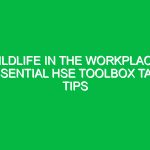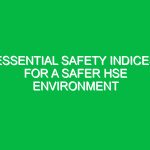Introduction
Hello team, and thank you for gathering today for this important Toolbox Talk. As we move into the winter season, it is crucial to focus on winter weather safety. Winter presents unique challenges that can impact our health, safety, and overall work Environment. Today, we will discuss the Hazards related to winter weather, the Best Practices to mitigate these risks, and how we can ensure a safe work environment for everyone.
Understanding Winter Weather Hazards
Winter weather can bring a variety of hazards that affect our work. These include:
- Ice and Snow: Slips and falls are among the most common injuries during winter months. Ice can form on walkways, stairs, and work surfaces, leading to serious injuries.
- Cold Stress: Prolonged exposure to cold temperatures can lead to conditions like frostbite and hypothermia.
- Reduced Visibility: Snowstorms and heavy snowfall can reduce visibility, making driving and operating equipment more dangerous.
- Equipment Malfunction: Cold weather can affect the performance of machinery and vehicles, potentially leading to breakdowns and accidents.
Real-Life Scenarios
Let’s consider a couple of real-life examples to illustrate these hazards. Imagine a worker who slips on an icy patch while carrying materials. Not only could they sustain an injury, but they could also drop the materials, leading to further hazards. Another scenario involves a worker operating a snowplow in poor visibility. If they do not take appropriate Precautions, they could accidentally collide with another vehicle or pedestrian.
Importance of Winter Weather Safety
Understanding the risks associated with winter weather is essential for maintaining a safe workplace. Implementing winter Safety practices not only protects our employees but also enhances productivity and reduces the potential for costly accidents. Remember, a safe work environment is a productive work environment.
Best Practices for Winter Weather Safety
Here are some Best Practices to follow during the winter months:
- Wear Appropriate Clothing: Layering is key. Wear moisture-wicking base layers, insulating layers, and waterproof outer layers. Don’t forget insulated gloves, hats, and thermal socks to protect extremities.
- Use Anti-Slip Footwear: Invest in shoes that provide good traction to help prevent slips and falls.
- Stay Hydrated: It’s easy to overlook hydration in cold weather, but it’s just as important as in the summer.
- Utilize Proper Equipment: Ensure that all tools and machinery are winter-ready. Check batteries, fluids, and other components before use.
- Clear Work Areas: Regularly remove snow and ice from walkways and work areas. Use salt or sand to improve traction.
- Plan for Reduced Visibility: When driving or operating machinery, reduce speed and increase following distances during snowy or foggy conditions.
Cold Stress Awareness
Cold stress is a serious condition that can affect workers exposed to low temperatures. It’s essential to recognize the early signs of cold stress:
- Frostbite: Look for symptoms such as numbness, pale skin, or hard skin. If frostbite is suspected, seek medical attention immediately.
- Hypothermia: Symptoms include shivering, confusion, and drowsiness. If someone shows these signs, get them indoors and call for medical help.
To prevent cold stress, encourage regular breaks in warmer areas and promote awareness of the symptoms among team members.
Emergency Procedures
Even with the best Precautions, emergencies can still happen. Here are some procedures to follow:
- In Case of Slip and Fall: If someone falls, assess their condition. If they are injured, do not move them and call for help.
- For Cold Stress Situations: If you suspect someone is experiencing cold stress, immediately move them to a warm place and provide blankets or warm fluids if they are conscious.
Regulations and Compliance
Understanding Regulations related to winter weather safety is also critical. OSHA (Occupational Safety and Health Administration) provides guidelines on working in cold environments. Compliance with these regulations not only protects our employees but also helps the company avoid legal issues and fines. Always review your company’s specific policies related to winter weather to ensure we’re all aligned.
Open Discussion
Now, I want to open the floor for discussion. What experiences have you had with winter weather at work? Are there any additional safety practices you believe we should implement? Sharing your thoughts can help us all prepare better and stay safe this winter.
Conclusion
In summary, winter weather presents unique challenges that we must proactively manage to ensure our safety. By understanding the hazards, following best practices, and being aware of regulations, we can reduce the risk of accidents and injuries. Remember, your safety is our priority, and it takes all of us to create a safe work environment. Thank you for your attention today, and let’s carry these practices forward into the winter season!


